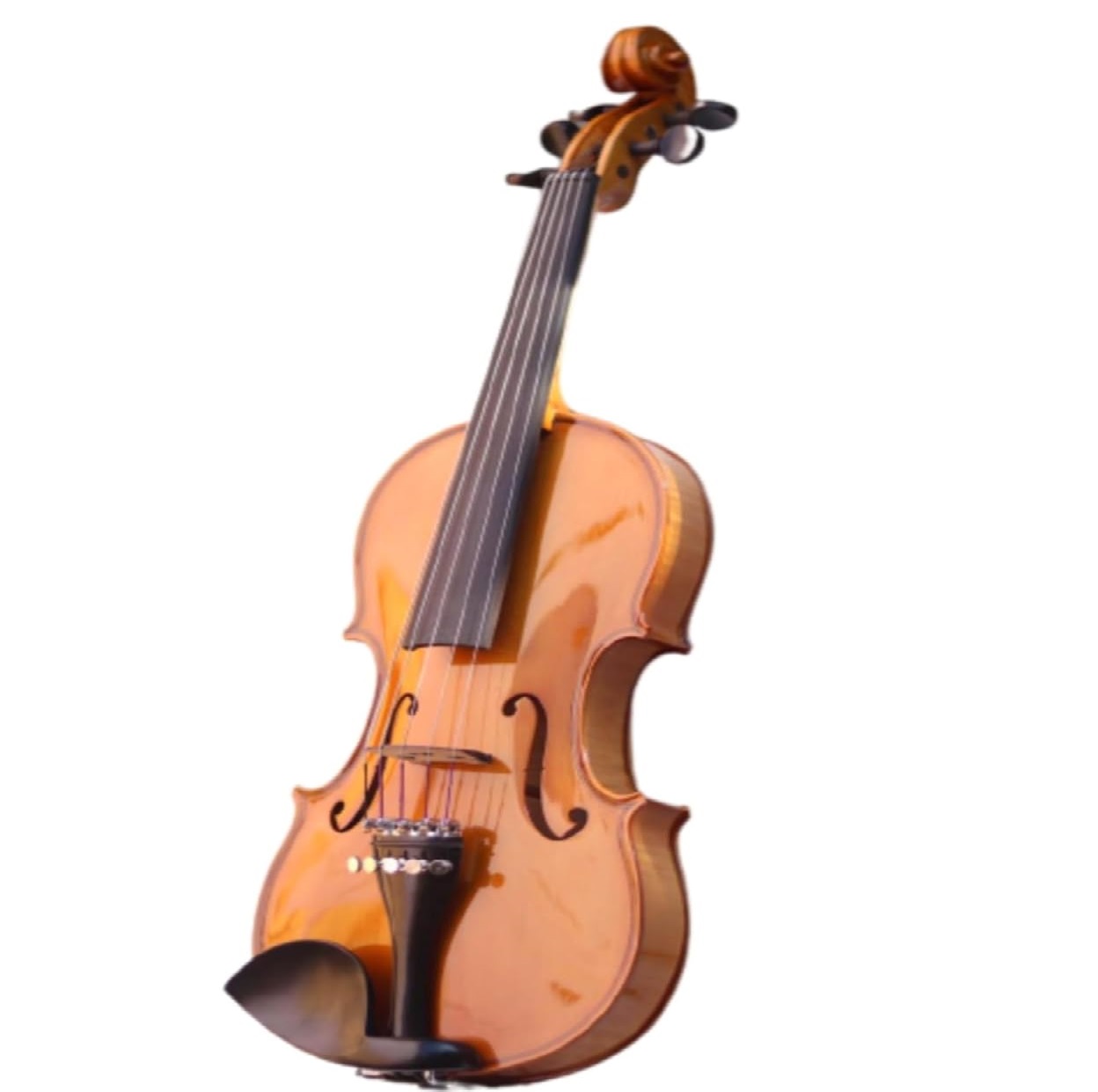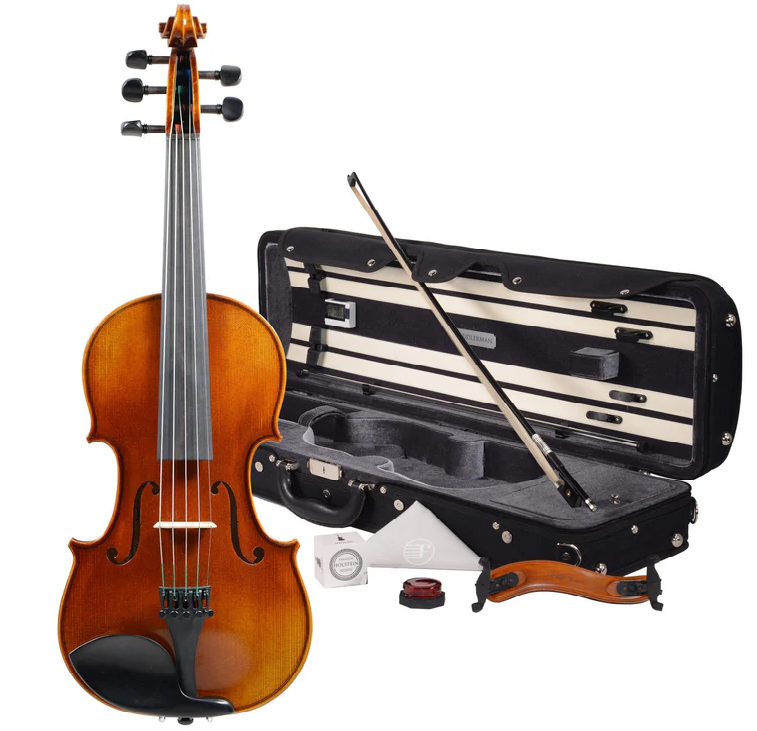Five-string violin
Bowed Instruments
Europe
Between 1001 and 1900 AD
Video
The five-string violin is a variant of the traditional four-string violin, featuring an additional lower string—usually a C string—alongside the standard G, D, A, and E strings. This instrument offers an extended range that allows players to explore deeper tonal registers while still maintaining the bright and expressive upper register typical of the standard violin. The addition of the fifth string enhances its versatility, making it an ideal choice for musicians who seek to blend the qualities of both the violin and the viola in a single instrument.
Type of Instrument: The five-string violin is classified as a bowed string instrument within the family of chordophones. It shares similarities with both the violin and the viola, as it incorporates elements of both instruments into its design and function. Like other bowed instruments, it is played using a bow strung with horsehair and produces sound through the friction of the bow against the strings.
History and Evolution
The five-string violin is a relatively modern innovation compared to the standard four-string violin, which has been in existence since the 16th century. While some experimental violin makers throughout history have explored additional strings, the five-string violin became widely recognized in the 20th and 21st centuries. The concept of adding extra strings to the violin has existed for centuries, often seen in baroque-era instruments such as the viola d’amore, which featured sympathetic strings. However, the five-string violin as we know it today emerged as musicians sought greater flexibility, particularly in jazz and folk music.
Development in the 20th and 21st Centuries
With the growing popularity of electric violins and modern innovations in acoustic instrument making, the five-string violin gained traction. Luthiers began designing instruments that could accommodate the additional C string without compromising the traditional violin’s tone and playability. Today, five-string violins are commonly found in various musical genres, from bluegrass to fusion jazz.
Construction and Design
The five-string violin retains the general appearance and structure of a standard violin but features key modifications to accommodate the additional string.
Body and Size
While some five-string violins maintain the same dimensions as a four-string violin, others have a slightly wider body or deeper ribs to enhance resonance, particularly for the lower C string. The choice of wood and craftsmanship significantly impact the tone, with high-quality woods such as spruce for the top and maple for the back and sides being standard.
Fingerboard and Neck
To support the additional string, five-string violins often have a slightly wider fingerboard and neck. However, they are still designed to be comfortable for violinists transitioning from a traditional four-string instrument.
Strings and Tuning
The standard tuning for a five-string violin is:
- G (lowest on a traditional violin)
- D
- A
- E (highest on a traditional violin)
- C (an extra lower string, borrowed from the viola)
This tuning provides violinists access to both the full violin and viola ranges, making it ideal for musicians who frequently switch between instruments. A regular violin bow can be used for a five-string violin, though some players prefer a slightly heavier bow to draw a richer sound from the lower C string. Some musicians also use synthetic or gut-core strings to enhance the tone and projection.
Types of Five-string Violins
There are several types of five-string violins, categorized based on their design, tuning, and purpose. Acoustic five-string violins maintain a traditional wooden body and are preferred by classical and folk musicians. Electric five-string violins, on the other hand, are designed with built-in pickups and often lack a traditional hollow body. These instruments cater to contemporary musicians in genres such as jazz, rock, and electronic music. Hybrid models exist as well, combining acoustic resonance with electronic amplification for greater versatility.
Playing Techniques and Sound Modifications
Playing a five-string violin requires an approach that balances elements of violin and viola techniques. Bowing must accommodate the wider range, with adjustments in pressure and positioning to produce a consistent tone across all five strings. Fingering can be slightly altered to allow smooth transitions between registers. In addition to standard acoustic techniques, players can modify the sound using electronic effects such as reverb, delay, and distortion, particularly when using an electric five-string violin.
The five-string violin opens up new possibilities for musicians, requiring adaptations in technique to take full advantage of its range.
Bowing and Articulation: Since the five-string violin has a broader pitch range, bowing techniques must be adjusted to achieve clarity between the lower and higher registers. Players often experiment with bow pressure and contact points to bring out the best sound from all five strings.
Fingering and Hand Position: With an extra string, finger placement requires subtle modifications. Some musicians adopt a more relaxed hand posture to accommodate the additional notes without excessive stretching.
Double Stops and Chords: The five-string violin allows for a richer harmonic vocabulary, making it particularly suited for jazz and folk improvisation. The lower C string enables deeper chords and extended harmonies not available on a standard violin.
Applications in Music
The five-string violin is used in a variety of musical genres, ranging from classical and jazz to bluegrass, rock, and fusion. In classical music, it offers an expanded range for soloists and ensemble players. Jazz musicians appreciate its ability to deliver both high-pitched improvisations and rich, viola-like tones. In folk and bluegrass, it provides a unique voice that complements traditional melodies while adding depth to the harmony. Additionally, the instrument is favored in experimental and electronic music, where its extended range and compatibility with effects open new sonic possibilities.
Choosing an Electric Violin
For musicians interested in an electric five-string violin, several factors must be considered. The build quality, weight, and balance of the instrument impact playability and comfort. The type of pickup system—whether piezoelectric or magnetic—affects the sound’s clarity and responsiveness. Some electric models feature a solid body, which minimizes feedback and allows for amplified performances without unwanted resonances. Players should also consider whether they require additional tone controls and built-in effects for greater sonic manipulation.
Maintenance and Care
Proper maintenance of a five-string violin ensures longevity and optimal performance. Regular cleaning of the body and strings prevents rosin buildup and preserves tonal clarity. The bow must be re-haired periodically, and the bridge and soundpost should be inspected for alignment. String replacement is essential for maintaining a rich sound, especially since the additional C string experiences significant wear over time. For electric models, maintaining the pickup system and checking cable connections are crucial to ensuring reliable amplification.
Advantages and Disadvantages
The five-string violin offers several advantages, including an extended range, enhanced versatility, and the ability to play both violin and viola repertoire. It allows musicians to explore new tonal possibilities and is particularly useful for improvisation and genre-blending. However, there are also disadvantages, such as a steeper learning curve due to the additional string and slightly altered finger positioning. The wider neck may require adjustment for players accustomed to a standard violin. Additionally, high-quality five-string violins can be more expensive than traditional four-string models, making them a significant investment.
Musical Applications
The versatility of the five-string violin makes it popular in a variety of musical genres.
Classical and Orchestral Use: Although not commonly found in traditional orchestras, the five-string violin is sometimes used in contemporary compositions and solo performances that require an extended range.
Jazz and Improvisation: Many jazz violinists favor the five-string violin because it provides access to deeper bass notes while still allowing for high-pitched melodic lines. Artists such as Christian Howes and Stuff Smith have demonstrated the instrument’s potential in jazz settings.
Bluegrass and Folk Music: In bluegrass and folk music, the five-string violin is prized for its ability to blend melody and harmony seamlessly. Players can switch between violin and viola roles, making it a valuable asset in ensembles.
Rock, Pop, and Contemporary Genres: Modern electric five-string violins have found a home in rock, pop, and fusion music, where their versatility enhances both lead and accompaniment roles.
Notable Five-String Violinists
Several prominent musicians have embraced the five-string violin, pushing its boundaries across various genres.
Mark O’Connor – A renowned fiddler and composer who has utilized the five-string violin in classical, jazz, and bluegrass settings.
Jean-Luc Ponty – A pioneering jazz violinist known for his fusion music, often performed on electric five-string violins.
Casey Driessen – A progressive bluegrass violinist famous for his rhythmic and percussive techniques on the five-string violin.
Christian Howes – A jazz violinist who has extensively explored the instrument’s harmonic possibilities.
In conclusion, the five-string violin is a remarkable instrument that bridges the gap between the violin and viola, offering musicians an expanded range and greater creative potential. Whether used in classical, jazz, folk, or experimental music, it provides a unique voice that enriches musical expression. With proper care and practice, the five-string violin can be a valuable addition to any musician’s arsenal, paving the way for innovative performances and new artistic explorations.
FAQ
What type of instrument is the five-string violin?
The five-string violin is a bowed string instrument. It extends the range of a traditional violin by adding a lower C string, allowing players to access both violin and viola registers.
Where did the five-string violin originate from?
The five-string violin originated as a modern adaptation of the classical violin. It became popular among jazz, bluegrass, and experimental musicians seeking extended range and versatility.
What is the five-string violin made of and how does it sound?
Typically made of spruce and maple, the five-string violin produces a warm, resonant sound. It blends the bright, expressive tone of a violin with the deeper, richer tones of a viola.
 Links
Links
References
- Introducing The Five-String Violin: Expanding The Range
- Transitioning From a 4-string to a 5-string Violin (and Back)
- The Five String Fiddle Conspiracy – Carruthers Violins
- 5-String Violin: What It Is & Exactly How It's Different
- 5 String Violins: The Black Sheep of the Family?
- 5 string violin - Glyn Jones, Violin maker and repairer
Other Instrument
Categories



















